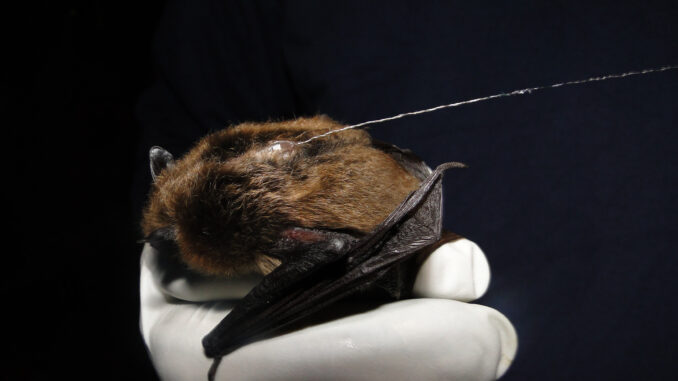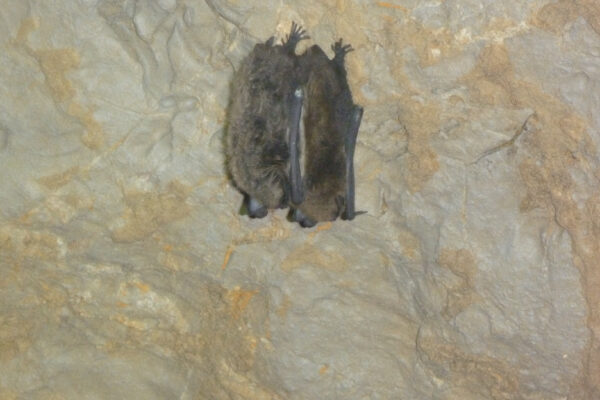

Photos of a little brown bat courtesy of CPW.
The fungus that causes white-nose syndrome in bats, Pseudogymnoascus destructans (Pd), has been found in a sample at a little brown bat maternity roost in the City of Fort Collins Gateway Natural Area.
Laboratory tests conducted this month at the National Wildlife Health Center in Madison, Wisc. confirmed that Pd was found in environmental swabs on the roost entrance. Guano samples of the site are pending. It is the second positive test for Pd this summer. The fungus was first detected in Colorado in a bat captured at Bent’s Old Fort National Historic Site in Otero County outside of La Junta, Colo. CPW and the U.S. Geological Survey (USGS) announced the positive detection on July 21.
Pd is an invasive fungus that causes white-nose syndrome (WNS) in hibernating bats. It can spread rapidly, primarily through bat-to-bat contact. There has not yet been a confirmation of a bat with WNS in Colorado, but the presence of Pd usually precedes confirmation of disease by one or two years.
White-nose syndrome is an invasive disease that has killed millions of bats in the United States, including over 90 percent of exposed populations of three bat species in fewer than 10 years.
Humans are not known to be affected, but humans can also spread the disease by visiting caves or other areas where bats roost.
“This detection not only adds a new location but also an additional species of bat that is positive for the fungus,” said Colorado Parks and Wildlife Species Conservation Coordinator Tina Jackson. “We will continue working with our partners and the public to identify additional roosts throughout the state for further monitoring.”
The City of Fort Collins Natural Areas Department plans to continue to protect this specific maternity bat roost and the building where the bats are, remains off-limits to the public. Natural Areas also conserve thousands of acres of bat habitat including wetlands and river corridors in and around the City of Fort Collins.
“Continued monitoring for symptoms of white-nose syndrome in bats and the number of bats in the roost will allow researchers to track the disease status and potential population changes,” said Jennifer Roberts, Environmental Planner for the City of Fort Collins Natural Areas Department. “Gateway Natural Area hosts a large maternity roost of little brown bats in the former Fort Collins water treatment plant. It is unknown exactly how many bats are occupying the roost, but it is thought to be the largest maternity roost in Northern Colorado. Protecting maternity roosts is important for keeping bat populations stable, especially during population stressors such as disease.”
The City of Fort Collins, CPW, the Colorado Natural Heritage Program, and other agencies will continue to monitor bats throughout the state and increase surveillance in the area of this finding in Northern Colorado.
Any new sign of Pd spread is worrisome because bats are an essential and beneficial part of the ecosystem. Bats play critical roles in insect control, and cave ecosystems and provide food for other animals.
State and federal agencies in Colorado and throughout the U.S. ask that outdoors enthusiasts help by following these recommendations:
- Stay out of closed caves and mines.
- Decontaminate footwear and all cave gear before and after visiting or touring caves and other places where bats live.
- Do not touch bats. Report dead or sick ones in quantities of three or more to CPW by calling 303-291-7771 or email [email protected].
- Gear and clothing used in areas where Pd or WNS occurs should not be used in areas where Pd is not known to occur.
- To avoid accidentally transporting bats, check canopies, umbrellas and other outdoor items for any bats that may have roosted in a nook or cranny.
Visit CPW’s website for more information on WNS.
According to the guidelines established under the national WNS response plan, Colorado remains in the “At-Risk/Intermediate” category for decontamination protocols because Colorado is adjacent to multiple states with confirmed WNS and now also has documented Pd detection within the state.
In 2018, Pd was documented in Wyoming so experts were not surprised by it showing up in Northern Colorado.
“Given the proximity of the Gateway Natural Area maternity roost to known positive sites in Wyoming, this detection is not unexpected,” Jackson said.
First documented in New York state in 2006, WNS has been confirmed in 12 North American bat species in 38 states and seven Canadian provinces. Colorado joins four additional states and one Canadian province where evidence of the fungus, but not WNS, has been found.
CPW and the USGS, along with U.S. Fish and Wildlife Service and National Park Service, have been conducting WNS surveys for over a decade, monitoring bats for presence of the fungus. Colorado is home to 19 native bat species, at least 13 of which may be susceptible to this disease. Colorado’s native bats are all insect eaters and use various habitat types across the state. They are most active during the summer months and spend the winter either hibernating in underground roosts throughout the state or migrating south.
See the full range of national decontamination guidance for the U.S. at whitenosesyndrome.org/static-page/decontamination-information.
Support Northern Colorado Journalism
Show your support for North Forty News by helping us produce more content. It's a kind and simple gesture that will help us continue to bring more content to you.
BONUS - Donors get a link in their receipt to sign up for our once-per-week instant text messaging alert. Get your e-copy of North Forty News the moment it is released!
Click to Donate
